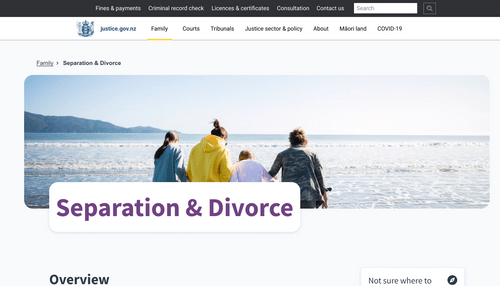
Ministry of Justice - Developing the re-design of the family section
Team (6):
UX/UI designer: Iqa Jamauldin, Julia Zhang, Matias Eeminyi, Nicolette Catalan, Paulina Ramirez, Yi-Chin Chyi
My Responsibility:
UX Research:
Work with MOJ project team to prioritize quantifiable and actionable feedback
Redesign design system/UI design
Usability Testing
I. OVERVIEW
The Ministry of Justice has not updated their web content since 2015, falling behind in the digital landscape. This led to a re-evaluation of the Care of Children(COC) section following the Te Korowai Tureā-Whānau (Family Court review) report, addressing concerns about the effectiveness and fairness of the New Zealand Family Court system.
II. THE CHALLENGE
How can we establish and apply a comprehensive Design System for the Ministry of Justice, merging successful features from the Care of Children update into the Family section to guarantee consistency and enhance the website's usability?
III. THE PROCESS

1. Desk Research
Our goal is to enhance site structure, navigation, and understanding of Ministry services by analyzing the website's and Design System's evolution through feedback, data analytics, and content review, and developing advanced information architecture concepts
Research Method
The simplest starting point was for everyone to do the
-Tear down
-Site map and information architecture

Keeping Children Safe Site map
Site map link
From our data analysis and observation, we've gained these insights:
The CoC section's detailed architecture aids content digestion but increases clicks and confusion. New design features improve usability but need user stories and better information architecture. Moving guidelines to Figma enhances accessibility, and high traffic to divorce pages highlights the need for scalable improvements in the Family section.
2. Interview
To achieve the set goals, in this part I collected information from interviews with subsequent stakeholders and comparative usability tests were conducted, then the data was analyzed using affinity mapping to get insights.
Research Method:
-Stakeholder interview
Participants were asked:
- User issues of the new/old design of Care of Children
- Usability test outcomes and Family section accessibility goals
- CMS Style Guide and Visual Design System purpose and improvements

I selected three participants with New Zealand residency status from social circle, with diverse backgrounds and life experiences that align with our website user demographic were selected.



- During the user test, participants satisfaction the new website's soothing colors, clear content, and legible text.
- They found the updated Care of Children section friendlier and valued the floating glossary.
- However, text-heavy content still overwhelmed some users, so clearer, simpler presentation is needed.

Through my participation in the IA card sorting test with stakeholders, I identified several key considerations that need to be addressed in the content redesign. We need to analyze heuristics, the LATCH framework, user navigation is seamless and the strengths and weaknesses of the 'Care of Children' and 'Separation & Divorce' sections.
-Wireframe


Participants were asked:
- Was it clear where to find the information?
- Were the instructions and requirements for the divorce application clear?
- What improvements would you recommend ?
- How easy was it to find information about dividing relationship property?
All participants successfully went from landing on the site to the ‘Where to start’ page.
Most participants think the intuitive navigation is effective, but further layout improvements are needed.
Three participants found that organizing content with real-life examples is very helpful. FAQs, and interactive features can enhance user experience.

V. FURTHER PLANNED IMPROVEMENTS
- Conducting additional usability tests enhancing navigation and comprehension.
- Implementing Skip Logic Forms and digital forms can streamline the website experience and simplifying processes.
- Continuous improvements will ensure the website serves users efficiently and informative experience.

